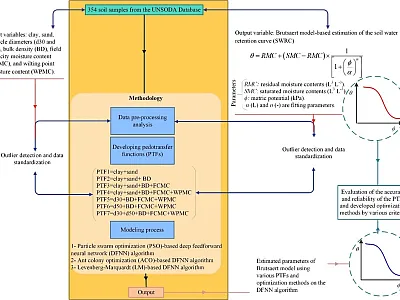Integrating Enhanced-Efficiency Fertilizers in 4R Nutrient Management
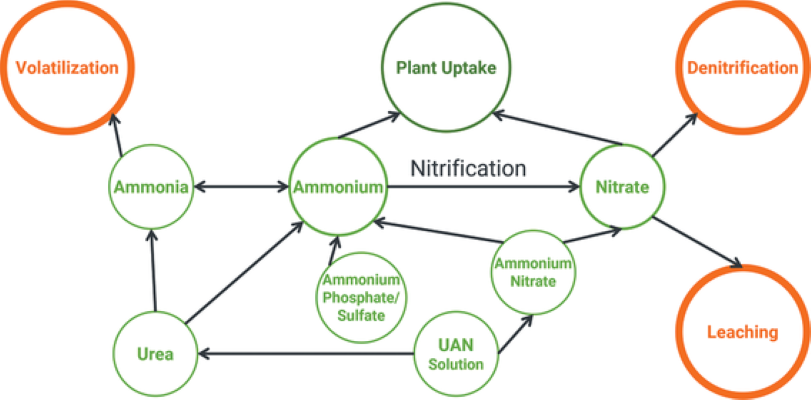
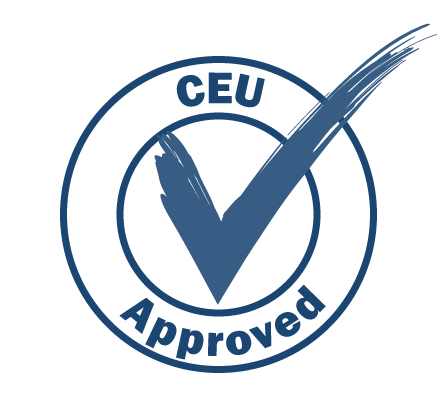
The 4R nutrient stewardship framework has brought us closer to improving our nutrient use efficiency. However, given the inherent “leakiness” of the N cycle, it is challenging to increase N use efficiency to optimum levels. Newer fertilizer technologies, like enhanced-efficiency fertilizers (EEFs), are tools that can help achieve this goal. To determine if EEFs should be incorporated into nutrient management programs, growers and crop advisers should consider the various types of EEFs available, their functions within the soil, and the timing of application relative to the crop’s nutrient uptake demand. Earn 1 CEU in Nutrient Management by reading this article and taking the quiz at https://web.sciencesocieties.org/Learning-Center/Courses.

Each season, growers aim to improve their precision nitrogen (N) management, and the benefits are obvious when achieved: increased N use efficiency reduces environmental impacts and translates to higher profits. Despite best efforts, the global N use efficiency is estimated to range between 10– 60% for corn (Kitchen, 2022). The 4R nutrient stewardship framework (applying the right rate, using the right source, at the right time, and in the right place) has brought us closer to improving our nutrient use efficiency. However, given the inherent “leakiness” of the N cycle, it is challenging to increase N use efficiency to optimum levels. Newer fertilizer technologies, like enhanced-efficiency fertilizers (EEFs), are tools that can help achieve this goal.
Enhanced-efficiency fertilizers are products that minimize nutrient losses by slowing nutrient transformations. These fertilizers can either slow the release of nutrients for uptake or alter the conversion of nutrients to other forms that may be susceptible to losses. Enhanced-efficiency fertilizers are most commonly designed for optimizing N; however, there are some EEFs designed for phosphorus (P) as well. Nitrogen tends to be a particular target because it is a highly reactive element in the soil, meaning it can quickly transform to different chemical forms. Enhanced-efficiency fertilizers are designed to keep N in forms that are less susceptible to loss and can be used optimize the time by which N transforms to available forms for crop uptake.
To determine if EEFs should be incorporated into nutrient management programs, growers and crop advisers should consider the various types of EEFs available, their functions within the soil, and the timing of application relative to the crop’s nutrient uptake demand.
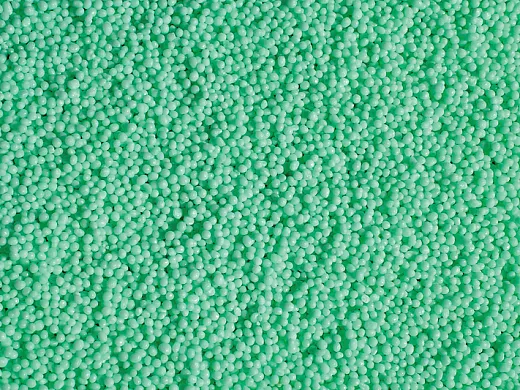
Types of Enhanced-Efficiency Fertilizers
Generally, EEFs can be placed into two main categories: slow- or controlled-release fertilizers and inhibitors/stabilizers.
Slow-release and controlled-release fertilizers are coatings on the fertilizer that slow the delivery of nitrogen over time. The time of N release is determined by the mechanism of release or method in which the fertilizer coating degrades or the nutrient diffuses through the coating. Degradation of the coating can be driven by physical processes (breakdown with exposure to water) or biochemical processes (breakdown from microbes and/or exudates).
Nitrogen availability of slow-release fertilizers is typically controlled by microbial or chemical decomposition and can be easily affected by moisture, temperature, and microbial activity. For controlled-release fertilizers, a physical coating is applied to the fertilizer, and the timing of N release is more predictable than slow-release fertilizers. The various soil factors impacting slow-release fertilizers make the N release more unpredictable. Though the mechanism of the release varies, the objective is the same for both controlled-and slow-release fertilizers: both slow the availability of N. Examples of these products include polymer-coated ureas (PCUs), methylene urea, and sulfur-coated ureas. All slow- and controlled-release products can reduce nitrogen loss from leaching, denitrification, and volatilization.
Inhibitors and stabilizers are additives that slow the changes to nitrogen that occur once it is applied to the soil. These products work by slowing the process of urea hydrolysis or by temporarily suppressing the microbial communities from rapidly transforming the nitrogen. The inhibitors can offer protection against volatilization, leaching, and denitrification (N2O and N2) losses, depending on the specific type. There are two types of inhibitors: nitrification inhibitors and urease inhibitors. Nitrification inhibitors slow the conversion of ammonium (NH4+) to nitrate (NO3–) by suppressing the Nitrosomonas and Nitrobacter microbes. Slowing down the amount of NO3– in the soil helps to reduce denitrification and leaching losses. The nitrification inhibitors help control losses for between four and eight weeks. Common active ingredients of nitrification inhibitors are nitrapyrin, dicyandiamide (DCD), and pronitridine. The other common inhibitor for N losses is a urease inhibitor. Urease inhibitors block the activity of the urease enzyme that is commonly found in soil and plant residues and breaks down urea into ammonium (NH4+). Urease inhibitors are specifically helpful in reducing volatilization losses for roughly 7 to 14 days. Common active ingredients for urease inhibitors are NBPT and Duramide.
Nitrogen Forms and Fates
Ultimately, N fertilizers convert to ammonium and/or nitrate, which are N forms the crop can take up (Figure 1). So, when considering N management, we are ultimately trying to manage the pools of ammonium and nitrate. While both ammonium and nitrate are plant-available forms, they are also susceptible to losses: ammonia through volatilization, and nitrate through denitrification and leaching. Given the reactive nature of N, all fertilizers are susceptible to ammonia and nitrate losses though some are more likely to be lost in one N pathway (e.g., anhydrous ammonia is susceptible to volatilization losses more so than leaching losses).
To assess N loss potential, the timing of N losses should be considered. Ammonia loss through volatilization to the atmosphere occurs within days (or at most a couple of weeks) of the application. However, leaching and denitrification of nitrate can occur at any time throughout the growing season. Nitrate is the form in which plants take up most of their N but is also susceptible to loss throughout the whole season. Both leaching and denitrification are controlled by water with waterlogged soils contributing to denitrification and excess water washing nitrate out of the root zone through leaching.
It is important to consider the timing of N losses when assessing EEFs. In general, controlled-release fertilizers will slow the release of N over a period of roughly 50 to 110 days when incorporated in soils (Ransom, 2020). Nitrification inhibitors will break down (no longer effectively suppressing N conversions) over a period of days to months, depending on the soil conditions, and urease inhibitors typically break down over a period of days to weeks (Hergert et al.,2011).
Enhanced-Efficiency Fertilizers and the 4R Nutrient Stewardship Framework
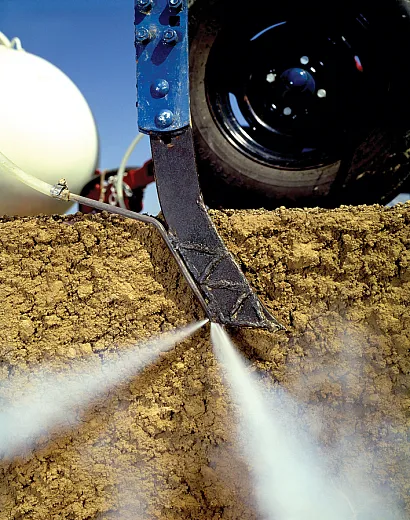
Using EEFs can support 4R nutrient stewardship aims by optimizing right source, time, place, and rate. Selecting the correct EEF to correspond with timing and placement can help maximize plant uptake and minimize losses. The EEF can also help deliver N at the right time, often extending N availability later into the season when crops need N most and allowing fewer and earlier application timings. In some cases, using a EEF could improve N use efficiency and allow for lower N rates without lower yields. Like rate, placement is also impacted with EEFs. The EEFs that keep N in the ammonium form help to keep N in the root zone as it is less likely to leach than in the nitrate form. Coordinating the use of “right source” EEFs with appropriate application timing and placement is an important 4R nutrient stewardship practice.
Enhanced-efficiency fertilizers can also be used to forward the aims of the 4R nutrient stewardship framework: to improve agricultural production while contributing to social well-being and minimizing environmental impacts. Enhanced-efficiency fertilizers are specifically designed to enhance nutrient use efficiency by delivering nutrients in a readily available form, optimizing crop yield and productivity. At the same time, EEFs can contribute to water quality preservation and mitigate emissions to the air of ammonia (NH3) and nitrous oxide (N2O).
Environmental Benefit of Enhanced-Efficiency Fertilizers
Numerous meta-analyses and research articles have been published outlining the effects of EEFs on yields and environmental loss reduction. There is clear consensus that these products can be used to reduce N losses while maintaining yields and that specific EEF products reduce specific N losses. A 2022 meta-analysis found that the overall range of N2O mitigation potential for the technology- driven solutions like EEFs was 22–49% (Grados et al., 2022). In another meta-analysis conducted by
Fan at el. (2022), the researchers found that urease inhibitors reduced NH3 volatilization by 51% and nitrification inhibitors reduced N2O emissions by 49%. The authors also stated using a combination of nitrification and urease inhibitors “...enables producers to balance crop production and environmental conservation goals without pollution trade-offs” (Fan et al., 2022). Older meta-analyses from 2016 found that nitrification inhibitors (DCD and nitrapyrin) were found to reduce emissions on average by over 40%, and polymer-coated urea reduced N emissions by 20% (Thapa et al., 2016). In addition to having improved N losses within the growing season, researchers also found that EEFs were effective in reducing annual mean emissions across the entire year, not just during the growing season (Pelster et al., 2023).
The environmental benefit of EEFs is clearly outlined in the scientific literature. It is evident that while these products are beneficial to the farmer, they are equally beneficial to society. Growers can attain improved yields and optimized N programs, but they are not paid for the societal benefit of reduced emissions. This illustrates the importance of including products like EEFs in conservation strategies supported by USDA-NRCS.
Determining Enhanced-Efficiency Fertilizer Usage in Nitrogen Management Programs
There are several factors to consider in determining whether an EEF should be incorporated in N management programs. It is essential to consider the N cycle and transformations of N and to have a specific goal in mind when choosing an EEF. Urea coatings will target slowing N availability for the entirety of the N cycle, urease inhibitors help reduce volatilization of ammonia, and nitrification inhibitors target denitrification, nitrous oxide emission, and leaching (Figure 2). In choosing N EEFs, have a very specific goal in mind and know your objective. Don’t select any EEF and expect results. Each EEF has a specific function, and choosing the wrong product will lead to disappointment. Identifying the N loss pathway and considering other factors like the soil and weather conditions for the target field is key to success with EEFs. Keep in mind N transformation is often driven by water, so also consider the water dynamics within farms/fields. Ask the following questions to help decide whether to use an EEF, if so, to select the best type:
- Where is my N system “leakiest,” and where is N is being lost? (Use Figure 2)
- What is my N use efficiency? Is there a part of the N cycle I can target to improve?
- (If already using an EEF) Am I choosing the right product for the problem?
- Will a split application help with my N use efficiency? If a split application isn’t an option, would a long-term EEF (e.g., controlled-release fertilizer) be something to try?
- What N sources am I using, and are they working well? Or is N being lost?
Consider the various stages of the N cycle (Figure 2) and which type of EEF could help. As with all nutrient management changes, it is best to test out products and practices in small field areas before making whole-operation changes. Test products at various N rates in to assess what works best for your operation.
Enhanced-efficiency fertilizers come at a premium price and should be used when the cost is justified and where the products will provide the greatest benefits. Selecting the right product for the problem is essential. Using a nitrification inhibitor to help with ammonia volatilization losses will not be effective and will lead to disappointing results. Just like all nutrient management decisions, poor management will reduce the effectiveness of the product; EEFs are not a band-aid solution to poor planning.
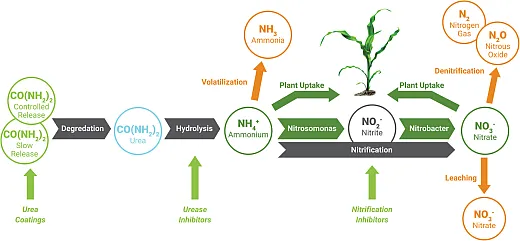
Various N sources will be better suited for particular EEFs. For example, UAN is already 25% nitrate-N, and applying a nitrification inhibitor thus protects only 75% of the N in the product. However, using a controlled-release urea or nitrification inhibitor in fields that are often under wet conditions is likely to improve your N use efficiency and bottom line.
Conclusion
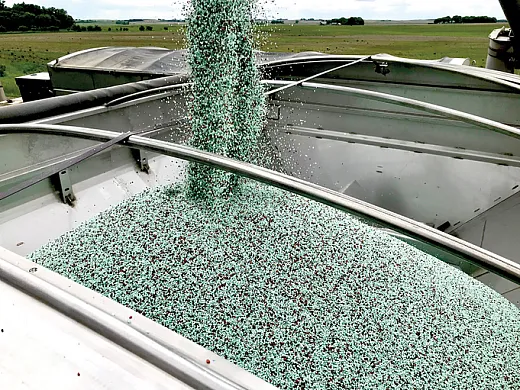
With the demand for continued improvements in conservation agriculture, EEFs serve as a valuable tool in the toolbox for 4R nutrient management. While EEFs are not the solution in every situation, they are a powerful tool for growers looking to get the most out of their N investment. At the same time, EEFs provide a valuable societal benefit through mitigating environmental N losses from agriculture without imposing yield penalties on growers. In choosing EEFs, growers should consider their specific objective and nutrient program. Selecting any EEF without deeper contemplation and consideration of the N cycle will likely lead to disappointing results. When implemented correctly, EEFs have great potential for substantial economic and environmental benefits.
References
Fan, D., He, W., Smith, W.N., Drury, C.F., Jiang, R., Grant, B.B., ... & Zou, G. (2022). Global evaluation of inhibitor impacts on ammonia and nitrous oxide emissions from agricultural soils: A meta-analysis. Global Change Biology, 28(17), 5121–5141. https://doi.org/10.1111/gcb.16294
Grados, D., Butterbach-Bahl, K., Chen, J., Jan van Groenigen, K., Olesen, J.E., Willem van Groenigen, J., & Abalos, D. (2022). Synthesizing the evidence of nitrous oxide mitigation practices in agroecosystems. Environmental Research Letters, 17(11). https://doi.org/10.1088/1748-9326/ac9b50
Hergert, G., Ferguson, R., Wortmann, C., Shapiro, C., & Shaver, T. (2011). Enhanced efficiency fertilizers: will they enhance my fertilizer efficiency? USDA. https://efotg.sc.egov.usda.gov/references/public/UT/EnhancedEfficiencyFertilizers.pdf
Kitchen, N.R., Ransom, C.J., Schepers, J.S., Hatfield, J.L., Massey, R., & Drummond, S.T. (2022). A new perspective when examining maize fertilizer nitrogen use efficiency, incrementally. PLoS ONE, 17(5), e0267215. https://doi.org/10.1371/journal.pone.0267215
Pelster, D.E., Thiagarajan, A., Liang, C., Chantigny, M.H., Wagner-Riddle, C., Congreves, K., ... & MacDonald, D. (2023). Ratio of non-growing season to growing season N2O emissions in Canadian croplands: an update to national inventory methodology. Canadian Journal of Soil Science, 103(2), 344–352. https://doi.org/10.1139/cjss-2022-0101
Ransom, C.J., Jolley, V.D., Blair, T.A., Sutton, L.E., & Hopkins, B.G. (2020). Nitrogen release rates from slow- and controlled-release fertilizers influenced by placement and temperature. PLoS One, 15(6), e0234544. https://doi.org/10.1371/journal.pone.0234544
Thapa, R., Chatterjee, A., Awale, R., McGranahan, D.A., & Daigh, A. (2016). Effect of enhanced efficiency fertilizers on nitrous oxide emissions and crop yields: a meta-analysis. Soil Science Society of America Journal, 80, 1121–1134. https://doi.org/10.2136/sssaj2016.06.0179
Self-Study CEU Quiz
Earn 1 CEU in Nutrient Management by taking the quiz for the article at https://web.sciencesocieties.org/Learning-Center/Courses. For your convenience, the quiz is printed below. The CEU can be purchased individually, or you can access as part of your Online Classroom Subscription.
- What is the primary goal of using enhanced-efficiency fertilizers (EEFs) in nutrient management programs?
- Increase water availability.
- Reduce nitrogen losses and maximize crop yields.
- Accelerate nutrient release.
- Minimize microbial activity.
- What is the estimated range of global nitrogen use efficiency for corn?
- 20–80%.
- 40–70%.
- 10–60%.
- 5–30%.
- What are the two main categories of enhanced-efficiency fertilizers (EEFs)?
- Fast and slow release.
- Slow and controlled release.
- Slow/controlled release and inhibitors/stabilizers.
- Inhibitors and stabilizers.
- How do slow-release fertilizers and controlled-release fertilizers differ in terms of their mechanism of nitrogen release and predictability?
- Timing of N release for slow-release is more predictable; controlled-release relies on microbial activity.
- Timing of N release for controlled-release is more predictable; slow-release relies on biochemical degradation.
- Timing of N release is unpredictable for both; they rely on physical breakdown.
- Timing of N release is equally predictable; controlled release is faster than slow release.
- What are the two main types of inhibitors used in EEFs, and how do they contribute to reducing nitrogen losses in the soil?
- Nitrification inhibitors and urease inhibitors; slow down nitrogen transformations.
- Nitrification inhibitors and urease inhibitors; stabilize microbial communities.
- Nitrification inhibitors and urease inhibitors; speed up nitrogen transformations.
- Fast release and slow release; control nitrogen release timing.
- According to the article, all fertilizer eventually converts to what two nitrogen pools that are also key for crop nutrition?
- Ammonia and nitrate.
- Ammonium and nitrate.
- Urea and ammonia.
- Urea and ammonia.
- Nitrification inhibitors slow the conversion of _______ _________and urease inhibitors slow conversion of _______ ________.
- Urea to NO3, NO2 to N2O.
- N2O to NO3, NH4 to NO2.
- NH4 to NO3, Urea to NH4.
- Urea to NH4, NH4 to NO3.
- What is the typical breakdown period for nitrification inhibitors vs. controlled-release fertilizers?
- Breakdown occurs over years; 50–110 days.
- Breakdown occurs over days to months; 50–110 days.
- Breakdown occurs within hours; 2–4 weeks.
- Breakdown occurs over weeks; 4–8 weeks.
- _________ is an example of an active ingredient in nitrification inhibitors, and _________ is an example of an active ingredient in urease inhibitors.
- Nitrapyrin, DCD.
- Nitrapyrin, NBTP.
- NBTP, DCD.
- Duramide, NBPT.
- What societal benefits result from using enhanced-efficiency fertilizers (EEFs), as mentioned in the article?
- Reduced soil erosion.
- Increased soil carbon and soil health.
- Decreased ammonia and nitrous oxide emissions.
- No impact on social well-being.
Text © . The authors. CC BY-NC-ND 4.0. Except where otherwise noted, images are subject to copyright. Any reuse without express permission from the copyright owner is prohibited.




